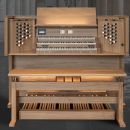Zwolle Grote-/of St. Michaelschurch
The Schnitger organ in the Grote Kerk is one of the most important European organs from the 18th century. The Baroque Organ was designed in 1719 by the most famous organ builder of the time, Arp Schnitger (1648-1719), and built by his sons Frans Casper and Johann Georg. The family came from the vicinity of Hamburg in Germany and, in addition to that city, also had workshops in Magdeburg, Bremen and Groningen.
Lightning strike and reconstruction.
Unique history
In 1669 the almost 115 meter high tower of the Grote Kerk, the highest in our country, was struck by lightning. In that impact, the wooden spire was lost and the tower was so badly damaged that it collapsed with a thunderous roar on December 17, 1682. The old organ was partly destroyed.
In the years that followed, no more organ music was played in the Grote Kerk and Zwolle had to make do with an organ in the Bethlehemkerk that did not function very well. The city had no money to build a new organ. The repair of the heavily damaged Grote Kerk took precedence. Moreover, it was not easy to find a good organ builder.

Zwolle Grote-/of St. Michaelschurch
Specifications
General
- Schnitger, 1721
- 4 manuals
- 63 stops






































